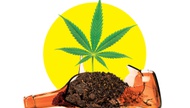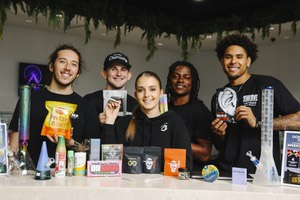As Las Vegas prepares to welcome valleywide cannabis consumption lounges, the state and hopeful licensees are grinding out details of how to safely operate them.
Regulations approved by the Nevada Cannabis Compliance Board in June require, among other things, that lounge operators have plans in place to prevent customers from driving under the influence, and to limit employees’ exposure to secondhand smoke. With consumption lounges expected to open as soon as this year, Executive Director Tyler Klimas says the Compliance Board will be coordinating with licensees to establish a blueprint for best practices and safe operating for an entirely new (sub)industry.
“Here in Nevada with consumption lounges, this is a new program, a new license type. So we’re really creating this whole part of the industry from scratch. We’re really ... looking to see what the licensees are going to put forth,” Klimas says.
The state will issue consumption lounge licenses to 20 independent operators and an estimated 40-45 established marijuana dispensaries. Several dispensaries have indicated plans to open lounges, pending successful applications and approval from the state compliance board. After a few more listening sessions with applicants, the license application period is expected to open in the fall, Klimas says.
The board has recommended a couple of measures—partnering with a rideshare service and having no-tow policies—to include in required risk mitigation plans. Regulations state that if an increase in impaired driving is found to stem from a lounge, the lounge will be required to “update” its mitigation plan.
Klimas says lounge licensees are expected to report instances or substantial risks of impaired driving, and the compliance board’s enforcement division will be making the rounds on “day two” of lounges being open, to see whether and how regulations could be strengthened.
“This is a highly regulated and privileged industry … There’s an onus on these operators to let us know,” Klimas says. “In addition to that kind of self-reporting, we also have our auditors and inspectors because we got a lot of new positions as a result of the passage of legislation. So we feel comfortable with our resources,” adding that coordination with law enforcement will be “integral” for public safety.
Making connections between forthcoming pot lounges and the possibility of increased DUIs might feel like déja vu. Similar concerns came to the forefront in 2016 when Nevadans were considering legalizing recreational marijuana.
Having had recreational dispensaries open for five years now, local governments and law enforcement have had some time to adjust to more people in the community consuming marijuana—and potentially getting behind the wheel while under the influence.
Data from the state Department of Public Safety does not indicate a clear trend with regard to fatal crashes where the driver was under the influence of marijuana. Nevada fatal crashes involving just marijuana increased by 38%—from 21 crashes in 2016 to 29 in 2017. In 2018, fatal crashes involving just marijuana decreased by about 20%, but increased again in 2019 by 30%.
According to a statement from the Nevada Highway Patrol, troopers are trained to conduct field sobriety tests if any impairment is suspected, and can ask for a blood test if marijuana impairment is suspected. “The individual would need to volunteer for the blood test. If they do not, the trooper would need to obtain a search warrant,” the statement says. Those who refuse a blood test are subject to the penalty of losing their license for one year.
The old concerns about marijuana DUI remain, especially with regard to pot lounges—now-legal places to consume marijuana outside of one’s residence or private property.
There is no set ratio of how much THC—the psychoactive compound in marijuana—someone consumes in one sitting, and for a true level of impairment, no chart showing how many hours one should wait to drive after smoking pot or taking an edible, says UNLV Assistant Professor of Psychology Dr. Dustin Hines.
Like alcohol, marijuana affects users differently, depending on the user’s sex, age or weight. On the other hand, tolerance to THC (which chronic and frequent users develop) factors into how much marijuana a person needs to consume to feel its effects, and the levels of THC that show up on a blood test for impairment.
“There’s definitely cases where people have high levels and they’re probably not that intoxicated. And also, you’ll have people that have low levels, and they’re very impaired,” Hines says, pointing to research that says a one-time or infrequent user’s intoxication from one puff of a joint could be considerably greater than that of a frequent or chronic user.
“You can have somebody that actually needs medical marijuana. They show up to work, and they’re not intoxicated. [But] because their levels are high, if they get injured, they can be in all kinds of problems, because it looks like they’re [high] at work when they weren’t,” he says.
Nevada lawmakers changed the state’s DUI laws surrounding marijuana impairment, getting rid of the numerical “per se” standard to determine impairment. Under per se DUI laws, a driver can be classified as impaired in a court of law, if they had a specified level of marijuana or marijuana metabolite in their blood at the time of a traffic stop or incident.
In 2021, the state legislature passed Assembly Bill 400, getting rid of per se thresholds to establish impairment. Officers still can use other observations and tests, such as field sobriety tests, to determine whether a person who has consumed marijuana, is too intoxicated or “impaired” to operate a vehicle.
Although marijuana does not have the same effect on all users, research has attempted to determine when it is safe to drive after ingesting it.
Hines points to one study that says the drug’s impairment on driving performance peaks around 20 to 40 minutes after inhalation, and impairment begins to diminish around one to three hours after inhalation. He adds that the way the drug is administered—whether by inhalation or eating an edible—has an effect on how long a person is intoxicated and potentially impaired.
“I’m always going to say, as a scientist, that we need more research,” Hines says, to better understand how much marijuana is safe to consume before getting behind the wheel.
For identifying intoxication and possible impairment in consumption lounge customers, the compliance board says it will “look for an emphasis on employee interaction and engagement with patrons in order to discourage impaired driving and identify signs of possible overconsumption,” in licensees’ DUI risk mitigation plans.
Click HERE to subscribe for free to the Weekly Fix, the digital edition of Las Vegas Weekly! Stay up to date with the latest on Las Vegas concerts, shows, restaurants, bars and more, sent directly to your inbox!





